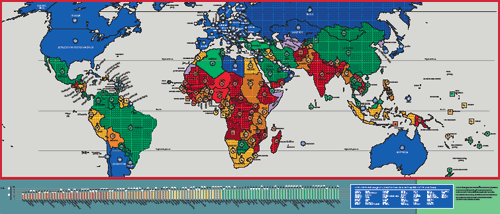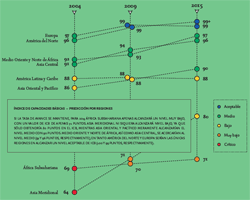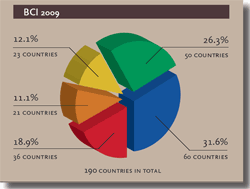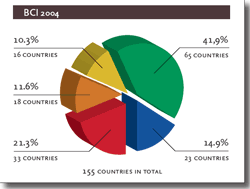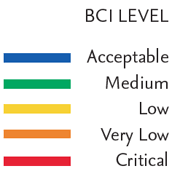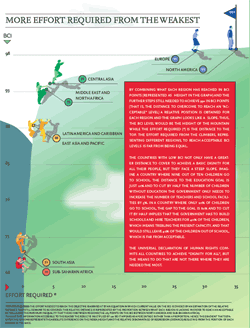Summary:
The BCI uses an alternative methodology to register the progress – or lack of progress – towards compliance with the Millennium Development Goals. This index constitutes a new methodology that complements in numerous respects the human development indexes most commonly used.
The BCI uses an alternative methodology to register the progress – or lack of progress – towards compliance with the Millennium Development Goals. This index constitutes a new methodology that complements in numerous respects the human development indexes most commonly used.
To reach an acceptable BCI does not imply a high level of social development. It merely signifies that the country has achieved universal coverage of minimum essential needs that are a prerequisite for advancing towards greater wellbeing. It is a departure point, not a destination.
Basic Capabilities Index: a starting point
Social Watch developed the BCI as an instrument to monitor the evolution of basic indicators and make comparisons between and within countries. This is a summary-index that compares and classifies countries according to their progress in social development by evaluating their situation in terms of minimum basic capabilities – structural dimensions that represent the indispensable starting conditions to guarantee an adequate quality of life.
The index identifies situations of poverty and it consists of three indicators:* the percentage of children reaching fifth grade, survival until the age of 5, and the percentage of births attended by skilled personnel. These indicators express different dimensions that are considered in internationally agreed development objectives (education, infant health and reproductive health). The BCI does not use income as an indicator. It defines poverty not in terms of money, but in different aspects of people’s actual condition and their greater or lesser possibility of having their human rights fulfilled.
The BCI is based on the latest available information for each country and it is easy to construct and can be applied at the sub-national and municipal levels. Since it does not include income as one of its components, it can be built without having to resort to costly household surveys, which is the problem with indexes based on income, such as the World Bank measure of the number of people living on less than one or two dollars a day, or the UNDP’s Human Development Index, which combines income with health and education indicators. Precisely because it dispenses with income as an indicator, the BCI has proved to be highly correlated with the measure of other human capabilities and, in particular, the 41 different indicators used to measure progress towards the different Millennium Development Goals agreed internationally in the year 2000. Contrary to the MDGs, though, the BCI can be used to assign a value to each country, so comparisons can be made with other countries and the progress can be evaluated over time.
The BCI indicators show maximum values when all women are attended by skilled health personnel at delivery, when no child drops out of school before completing the fifth grade and when infant mortality is brought down to its lowest possible level of less than five deaths among children under five years old per thousand live births. These indicators are closely linked to the other basic capabilities the members of a society should have, capabilities that reinforce each other to make better individual and collective development possible.
The 2009 BCI was calculated for 175 countries, and these are grouped in various categories**. The countries in the most serious situation are those with a Critical BCI (less than 70 points). In the Very Low BCI category (from 70 to 79 points) there are countries facing major obstacles to achieving well-being for the population. The countries with Low BCI (from 80 to 89 points) are at an intermediate level as regards the satisfaction of basic needs, and their performance varies in some dimensions of development. The countries that have progressed and now satisfy most or all the population’s basic capabilities are in the two categories with the highest values: Medium BCI (from 90 to 97) and Acceptable (more than 98 points and more).
The BCI of a country approaches 100 when there is universal access to the three minimum levels of social coverage mentioned above. These factors indicate the satisfaction of the most fundamental of all social rights, which are access to adequate health care, and universal, good quality basic education.
Social Watch understands that a BCI value close to the maximum reflects the “dignity for all” proclaimed by the Universal Declaration of Human Rights. Reaching this level does not mean that a country has attained all the goals of social well-being that are desirable in a society; it merely indicates a starting point towards those goals.
* The BCI originated in the Quality of Life Index developed by the non-government organization Action for Economic Reforms (Philippines), which was derived from the Capability Poverty Index proposed by Professor Amartya Sen and popularized as the UNDP Human Development Index.
** The methodological process designed to estimate BCI values when there is a lack of information for one of the indicators that makes up the value consists of the following.
a) Countries are considered on a regional basis, and only those that are in a similar relative situation to the country for which information is lacking are considered. This implies the assumption that countries are similar in terms of performance to neighbouring countries at a similar level of development. (Countries designated “high income” by the World Bank are classified in sub-regions, thus increasing the total from 8 to 15 regions.)
b) An average of the values for the missing indicator is made just from the countries in the same region.
c) The average of indicators with information is estimated for all the countries.
d) The arithmetical mean or average is calculated among the mean values calculated in “c” (only among countries in the region corresponding to each concrete estimation need).
e) The value obtained in “d” is subtracted from each value obtained in “c”, which yields a correction factor for each country.
f) The value obtained in “b” is added to the value obtained in “e”, which yields a correction of the regional mean either up or down in function of the mean performance registered for each country, in the two indicators for which information is available.
g) And lastly, the value obtained in “f” is imputed to the countries in that region and in a similar relative situation for which the data in question is not available.
h) If as a result of the procedure outlined above the indicator exceeds 100 points, and as we are dealing with a percentage, the value of 100 points is given as this is the maximum possible.





